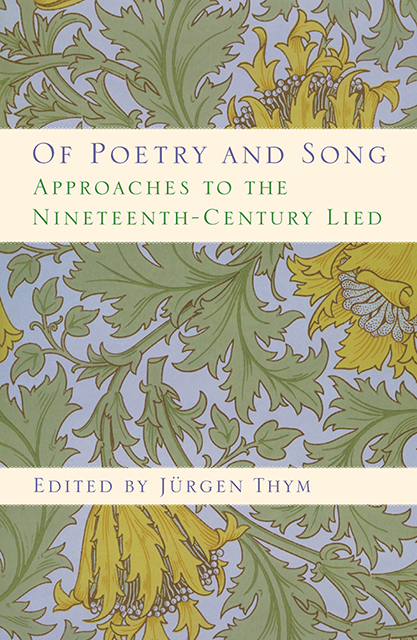Chapter Ten - Schubert’s Strategies in Setting Free Verse
Published online by Cambridge University Press: 02 March 2023
Summary
Free verse is a contradiction in terms. What makes this kind of poetry verse, and what makes it free? And if it is verse, why is it free? Anglo-American and German critics differ considerably in their handling of this question, defining free verse in different ways; even within both traditions a great deal of disagreement exists. This is not the place to explore the various approaches to free verse; let us simply say that for the purpose of this study we are working with a definition that might be termed visual or graphic.
In its most provocative form—we are borrowing here from John Hollander— the visual definition sees free verse as a narrow strip of print constrained only by the need not to exceed too far to the right-hand margin of the page. This definition plays into the hands of those who regard free verse as prose chopped pretentiously into lines to make it look like poetry. But despite its flippancy the definition has some merits. Phrased in a more dignified way, it means that the presence of line boundaries signals to the reader that the lines are to be read with the conventions our particular tradition has developed for reading poetry. Furthermore, the line boundaries offer the reader a basis for such a reading. The end/beginning of one line, for example, can be compared to the end/ beginning of another; the beginning of a line can be compared to its end; the relation of syntax to line structure can be observed, with the concomitant presence or absence of enjambements; the syntax can be compared to “normal” syntax, and so on. John Hollander explores some of these possibilities in several chapters of Vision and Resonance, and Charles Hartman works with a version of this definition when he defines poetry inclusively as “language in lines” and free verse as lines organized by non-metrical patterns. Despite its virtues, this definition raises the real and important questions as to whether free verse can be set as free verse and whether settings of free verse can be distinguished from settings of prose. Nevertheless, we found this visually based definition of free verse most useful for approaching the question of how poetic form affects musical form in free verse settings.
- Type
- Chapter
- Information
- Of Poetry and SongApproaches to the Nineteenth-Century Lied, pp. 261 - 280Publisher: Boydell & BrewerPrint publication year: 2010
- 1
- Cited by



